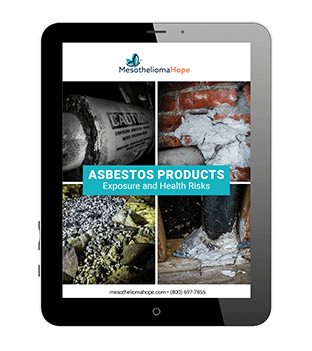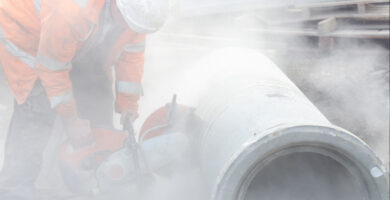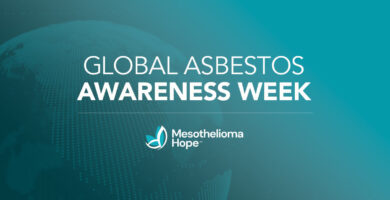There are no known immediate symptoms of asbestos exposure, even if you’ve breathed in high amounts of asbestos. Instead, the health effects take years or even decades to develop, with the earliest sign usually being shortness of breath. If you think you were exposed to asbestos, talk with your doctor about getting screened for mesothelioma.
What Are the Health Hazards of Asbestos Exposure?
Asbestos is a known human carcinogen with no safe level of exposure, according to the U.S. Environmental Protection Agency (EPA) and the International Agency for Research on Cancer (IARC).
Unfortunately, millions of people were exposed to the toxic mineral from the 1930s to the early 1980s and are at risk of developing several serious diseases years later. Most notably, asbestos is the only known cause of mesothelioma, an aggressive and rare cancer that forms in the lining of internal organs.
Additional asbestos-related diseases include:
- Asbestosis
- Lung cancer
- Pleural effusion
- Pleural plaques
- Other cancers
Because asbestos was used in thousands of products in factories, shipyards, and the military, people could have been exposed at work or even at home.
To learn about products that contained asbestos and whether you might have been exposed, get our Free Asbestos Products Guide now.
When Do Asbestos Exposure Symptoms Begin?
The initial signs of asbestos exposure usually don’t start until at least 10 years after the first exposure. Sometimes, it can take as long as 50 years before the damage from asbestos begins to cause symptoms.
When a person is exposed to asbestos, they can breathe in or swallow small fibers that get lodged in the tissues covering the lungs, abdomen, or other areas. Over the years, the fibers can cause irritation, inflammation, and permanent tissue damage. This is when symptoms may begin to appear.
Early symptoms of mesothelioma and other asbestos-related diseases may include:
- Bloating, swelling, or lumps in areas around the body
- Fatigue
- Hoarseness
- Night sweats
- Pain in the abdomen, back, or chest
- Persistent and sometimes bloody cough
- Shortness of breath
- Weight loss
Some conditions and lifestyle choices may make symptoms appear sooner. For example, smoking cigarettes greatly increases the risk of lung cancer from asbestos exposure.
A smoker who is heavily exposed to asbestos is up to 90 times more likely to get lung cancer than a non-smoker who was exposed, but they might not consider their symptoms related to asbestos.
Who Is at Risk for Diseases Caused by Asbestos Exposure?
Individuals who are most likely to develop asbestos-related diseases are usually those who were exposed on a regular basis, most often at a job where they worked directly with asbestos-containing products.
Occupations at high risk of asbestos exposure include:
- Asbestos abatement (removal)
- Auto and aircraft repair
- Construction and carpentry
- Demolition
- Firefighting
- Insulation
- Manufacturing
- Mining and milling
- Shipbuilding
Additionally, U.S. veterans are at high risk of asbestos-related diseases since every branch of the military used asbestos to reinforce buildings, equipment, and other assets until the early 1980s.
As a result of widespread asbestos use in the military, about 33% of people diagnosed with mesothelioma today are veterans.
Unfortunately, even those who didn’t work in these occupations could still be at risk. In fact, cases of mesothelioma have also been found in areas located close to asbestos mines. Others have gotten sick from asbestos fibers that their loved ones unknowingly brought home on their work clothes.
It’s even possible for people to be exposed to asbestos without even knowing it because the mineral lurks in many older buildings across the United States.
Get more information about asbestos products and how or where you might have been exposed in our Free Asbestos Products Guide.
How Are Asbestos-Related Diseases Detected?
People who have been exposed (or think they may have been exposed) to asbestos fibers should inform their doctor about their asbestos exposure history and any symptoms they may have.
After a physical and lung function test, doctors can perform a series of imaging scans to detect signs of asbestos disease or damage to the body.
These tests include:
- CT scans
- MRIs
- X-rays
Although imaging scans cannot detect asbestos fibers in the lungs, they can help find early signs of damaged tissue so doctors can take a biopsy.
The only way to confirm a mesothelioma diagnosis is to get imaging scans and have any abnormal tissue biopsied.
During a biopsy, a doctor will take a small tissue sample and have it examined in a lab to determine if the cells are cancerous or benign (not cancerous). If they are benign, it’s still possible you may have developed another chronic asbestos disease.
Get Help Pursuing an Accurate Diagnosis
Because symptoms of asbestos exposure take years or even decades to develop, diagnosing mesothelioma is extremely difficult. The best way to get an accurate diagnosis is to work with a mesothelioma specialist who has the expertise to spot mesothelioma.
If you or a loved one is struggling with the symptoms of mesothelioma after being exposed to asbestos, help is available.
At Mesothelioma Hope, our Patient Advocates can help you:
- Find a mesothelioma specialist near you so you can get a timely diagnosis
- Understand your options for treatment
- Seek financial assistance to help pay for treatment and other expenses
We are dedicated to walking alongside you in this journey and providing your family with personalized support so you can focus on your family without worrying about the financial impact. Call us at (866) 608-8933 now to get started.










